Extinctions used to be nature’s way of clearing the decks for new species to emerge. There have many many mass extinctions even in the distant past, the most notable of which was the extinction of at least most of the dinosaurs 65 million years ago, thanks, archaeologists believe, to a well-aimed meteor.
But with the arrival of humans, extinctions are no longer the prerogative of nature. Humans gleefully hunted many species to extinction, though, admittedly, the belief systems of many cultures didn’t think hunting an animal to extinction was possible. When people understood that animals could be wiped out because humans wanted them for food or for their fur or feather or hides or to simply put their heads on the wall, species were still threatened by habitat destruction, pollution, poisoning, poaching, and climate change. Largely because of this, the world is in the midst of yet another mass extinction. Here is a list of 12 animals that have gone away forever over the last century:
Animals That Have Gone Extinct in the Last 10 Years
Despite the efforts of conservationists and awareness of the need to protect certain species, too many animals have gone away for good over the last 10 years. They include:
#13 Extinct Animals: Ivory-Billed Woodpecker
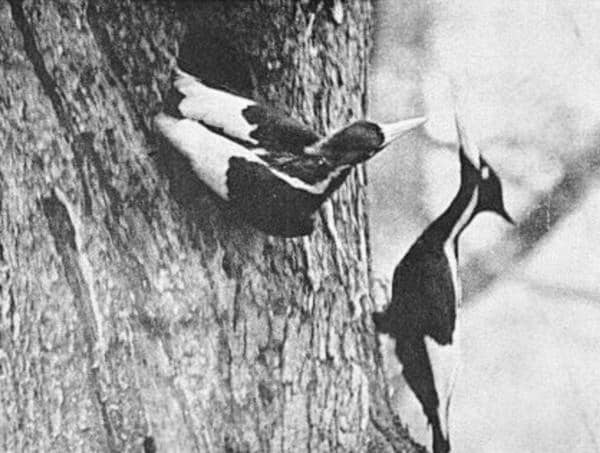
©Arthur A. Allen, Public domain, via Wikimedia Commons – Original / License
While the ivory-billed woodpecker was officially declared extinct in 2021 by the US government, there’s a possibility that the declaration could be overturned, pending some unreviewed reports. But this magnificent North American bird was the largest of the woodpecker species, ranging from 18-20 inches in length. It feasted on beetle larvae underneath the bark of trees, accessed by its ability to strip the bark away with its powerful beak. Its body was black and it sported two white stripes down its neck and a stand-out tuft of red feathers on its head.
#12 Extinct Animals: West African Black Rhinoceros
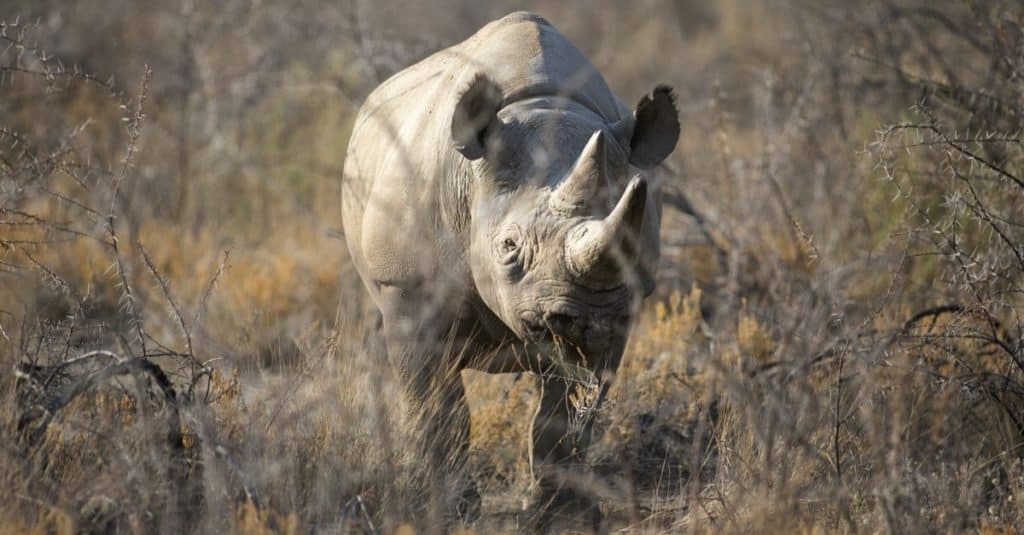
.
©2630ben/Shutterstock.com
This magnificent animal went extinct in 2011 thanks to habitat destruction, trophy hunting, and especially, poaching. The animal was extensively killed for its horns, which were believed to have medicinal properties when powdered and ingested. The western black rhino, a subspecies of the black rhino, was once abundant in sub-Saharan Africa, especially in Cameroon. The western black rhinoceros was between 9.8 and 12.3 feet in length, 4.6 and 5.9 inches at the shoulder and could weigh as much as 3090 pounds. It also had two horns, the longest of which could be as long as 4.6 feet.
#11 Extinct Animals: Pinta Giant Tortoise

©evenfh/Shutterstock.com
The Pinta Giant Tortoise, or Pinta Island Tortoise, went extinct in 2015. It was a kind of Galapagos tortoise that was found on Pinta Island and wiped out mainly through subsistence hunting. It was one of 21 species in the genus Chelonoidis, and its scientific name was Chelonoidis abingdonii. The carapace was distinctive because it was shaped like a saddle, and the tortoise has an unusually long neck.
The last Pinta Island tortoise, Lonesome George, died on June 24, 2012. Biologists tried to have him mate with females of related species, but nothing worked. His age was estimated to be between 101 and 102 years. His taxidermied body is now on display at the Galapagos Islands’ Fausto Llerena Breeding Center.
#10 Extinct Animals: Formosan Clouded Leopard

.
©Joseph Wolf, Public domain, via Wikimedia Commons – Original / License
The beautiful Formosan Clouded Leopard was classified as extinct in 2013, even though the areas where it was last seen were protected, and the Rukai people of the area considered hunting the cat taboo. It was found only in Taiwan, whose former name was Formosa. It was the island’s second-largest carnivorous animal behind the Formosa black bear, a subspecies of the Asiatic black bear. This animal is still extant but listed as vulnerable.
The background color of the leopard’s fur was pale or tawny brown, and it had markings on its sides and shoulders that resembled dark clouds. Its tail was shorter than those of other clouded leopards. The reason for its disappearance was most likely habitat destruction due to logging.
Animals That Have Gone Extinct in the Last 20 Years
#9 Extinct Animals: Yangtze River Dolphin
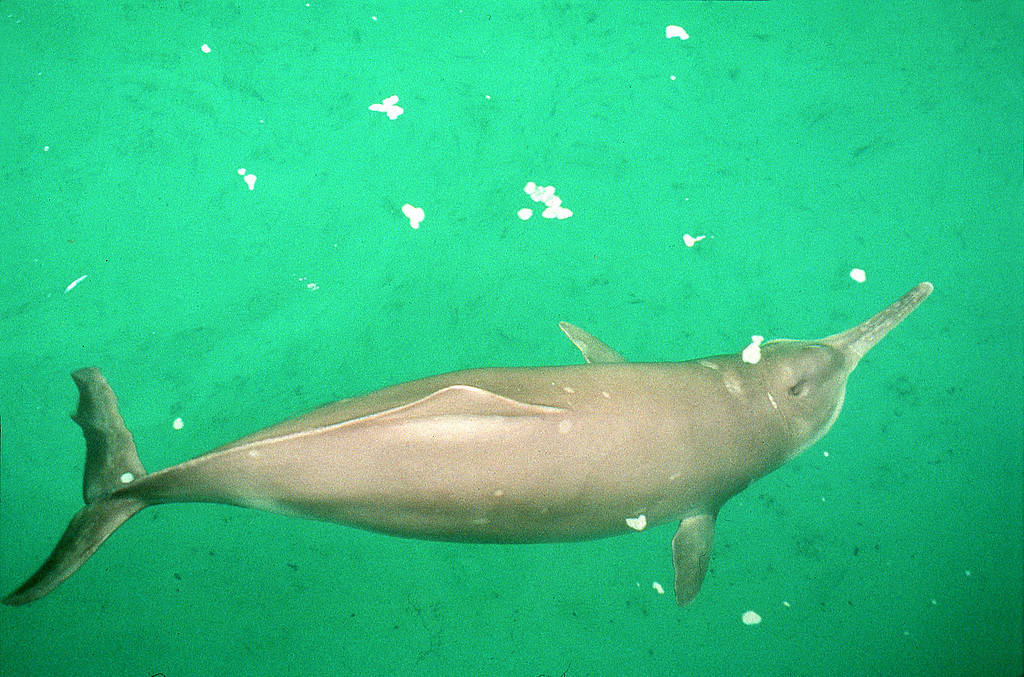
©iStock.com/EarthViews Productions
This dolphin also called the baiji was believed to be extinct in the wild as of 2008, though there are some individuals in captivity. Its demise is blamed on hunting the dolphin outright, overfishing where the dolphin was caught in nets or killed through electrical shocks, collisions with vessels, pollution and the devastating impact on its environment due to the building of the Three Gorges Dam. This happened even as this dolphin is part of Chinese folklore, is a symbol of peace, beauty and prosperity and is actually known as the “Goddess of the Yangtze.”
The baiji is small as dolphins go, with males being around 7.5 feet long and females being over 8 feet long. Their backs are gray or pale blue, and they have a white belly and a long narrow beak full of cone-shaped teeth. Its eyes are small, as it doesn’t need to see well in the murky river.
#8 Extinct Animals: Christmas Island Pipistrelle
This smallest bat in Australia is believed to have gone extinct in 2009. It was endemic to Christmas Island. It had brownish, yellow-tipped hair, triangular ears and a small tail. The length of its body was only between 1.4 to 1.6 inches long, and its tail was 1.2 inches long. It ate insects and spent its days sheltering in tree cavities and rotting vegetation. Unlike most of the species listed here, no one really knows what caused this tiny bat to go extinct, though the introduction of predators such as feral cats, rats, snakes or the notorious yellow crazy ant may be a culprit.
#7 Extinct Animals: Saudi Gazelle

©Buffon, Georges Louis Leclerc; Imprimerie de Lacrampe; Lesson, R. P., Public domain, via Wikimedia Commons – Original / License
This graceful animal that once roamed the Arabian Peninsula was declared extinct in 2008, though some biologists believe it was gone well before that year. Scientists used to believe the Saudi gazelle was simply a subspecies of the Dorcas gazelle, which is common but vulnerable. The Saudi gazelle was a bit shorter and had a lighter coat. The animal had always been rare and overhunting probably sealed its fate.
Animals That Have Gone Extinct in the Last 50 Years
#6 Extinct Animals: Pyrenean Ibex
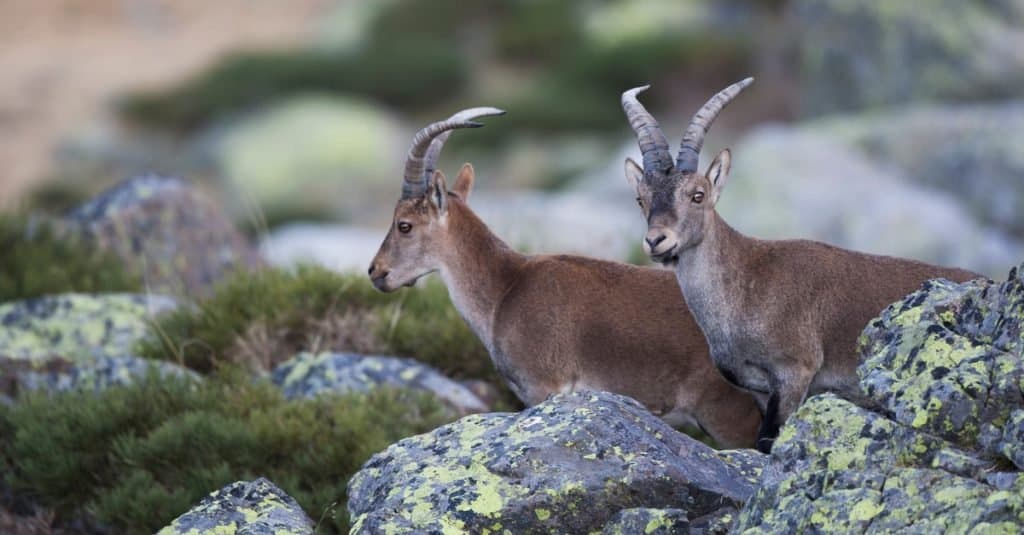
.
©Alexandre Boudet/Shutterstock.com
The Pyrenean Ibex was famous for its amazing pair of huge, curved ridged horns sported by the male. This wild goat lived in the Pyrenees mountains between Spain and France, and was called bucardo or herc in Spain and bouquetin in France.
Besides his horns, the male had a gray or grayish-brown coat with black markings that grew out in the winter. The female had a mostly brown coat, and her horns were short and curved backwards. The species was migratory and would move up the mountains to mate. Females came down the mountain in the spring to give birth. In the winter, the ibex moved to valleys that were clear of snow and provided food. The Pyrenean ibex was declared extinct in 2000.
#5 Extinct Animals: Javan Tiger
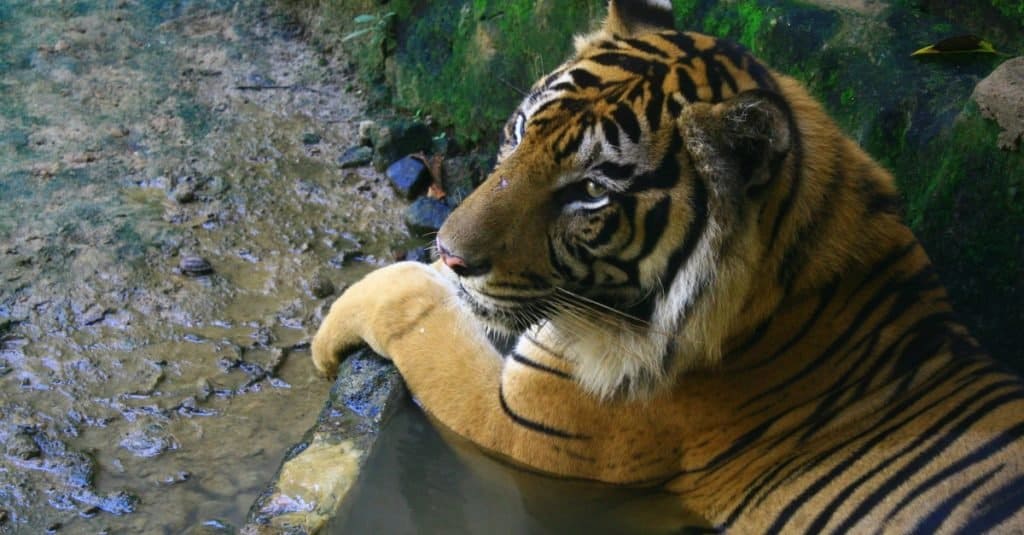
©Sigit Adhi Wibowo/Shutterstock.com
The Javan tiger was declared extinct in 1979 and was possibly extinct before this. As its name says, it was found on the island of Java in Indonesia. It was once thought of as subspecies of tiger, and it was indeed smaller than some of its cousins. Males were about 98 inches long and weighed between 220 and 311 pounds, while females were a little smaller and weighed between 165 and 254 pounds. It was also distinct from other tigers in that it had long, thin stripes and could allegedly break the leg bones of horses and water buffaloes with a swipe of its paw. This tiger was simply hunted to extinction and its hunting grounds converted to farmland.
#4 Extinct Animals: Guam Flying Fox
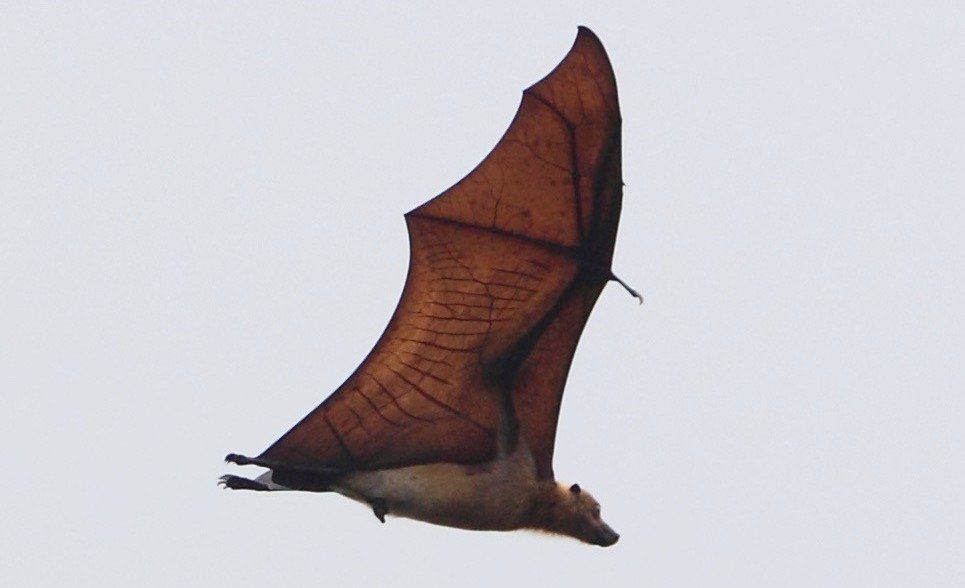
This little fruit bat of the island of Guam was believed to have gone extinct around 1968, most likely because of habitat change or overhunting. It was only about 6 inches long, had a 28-inch wingspan and weighed no more than 5.4 ounces. It was grayish on the top of its head, golden brown at the neck and brown everywhere else. It was hunted for food and also became prey of the invasive brown tree snake, which not only probably caused its extinction but caused the extirpation of all the native birds of Guam.
Animals That Have Gone Extinct in the Last 100 Years
#3 Extinct Animals: Schomburgk’s Deer

This deer, which was declared extinct by 1938, was native to Thailand. It looked much like the white-tail deer and had a dark brown body with a white belly. The underside of its tail was also white, and the male had graceful antlers with as many as 33 points. Females lacked antlers. The deer lived around swamps and formed groups made up of one male, a number of females and fawns. What made them vulnerable was that when the places where they lived flooded they’d have to climb up to higher ground. This made them easy pickings for hunters. Besides hunters, habitat destruction sealed the deer’s fate when swamps began to be converted into rice paddies.
#2 Extinct Animals: Crescent Nail Tail Wallaby
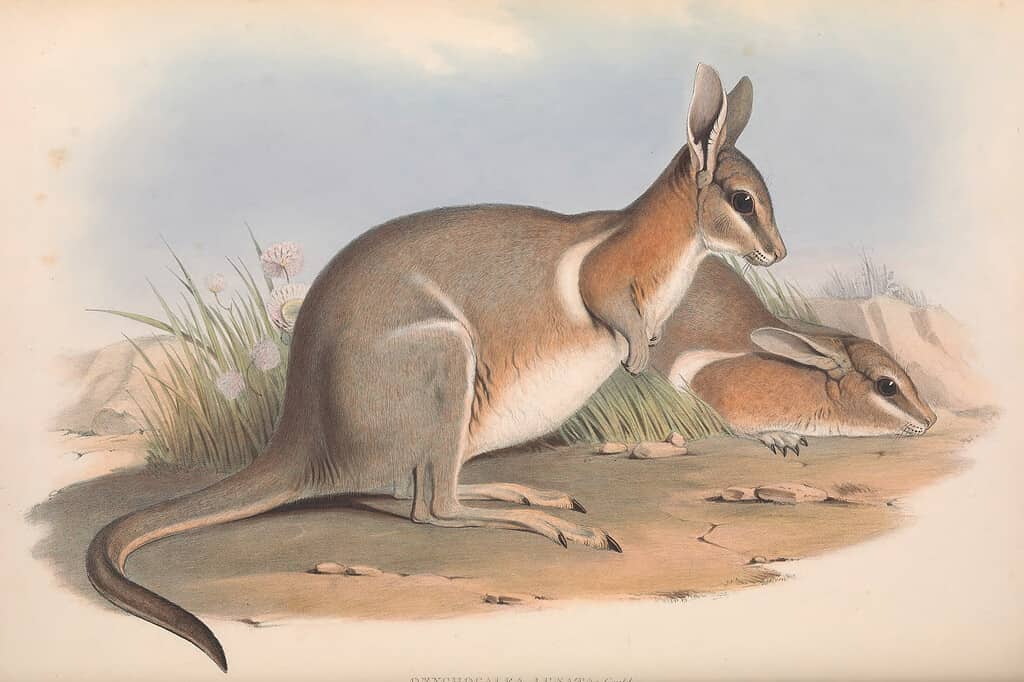
.
©John Gould, Henry Richter, Public domain, via Wikimedia Commons – Original / License
This little marsupial also called the worong, was believed to have gone extinct in the 1950s. Found in central and southwest Australia, it got its name because the tip of its tail bore a structure that looked like a nail or a claw. It was an attractive wallaby with soft fur and a white crescent that swept around their body to just above their legs. It weighed about 7.7 pounds and had a body length that was between 14.5 to 20 inches, with a tail that was about 5.9 to 13 inches. It was hunted for food, and it is believed that predation by the fox contributed to its end.
#1 Extinct Animals: Xerces Blue
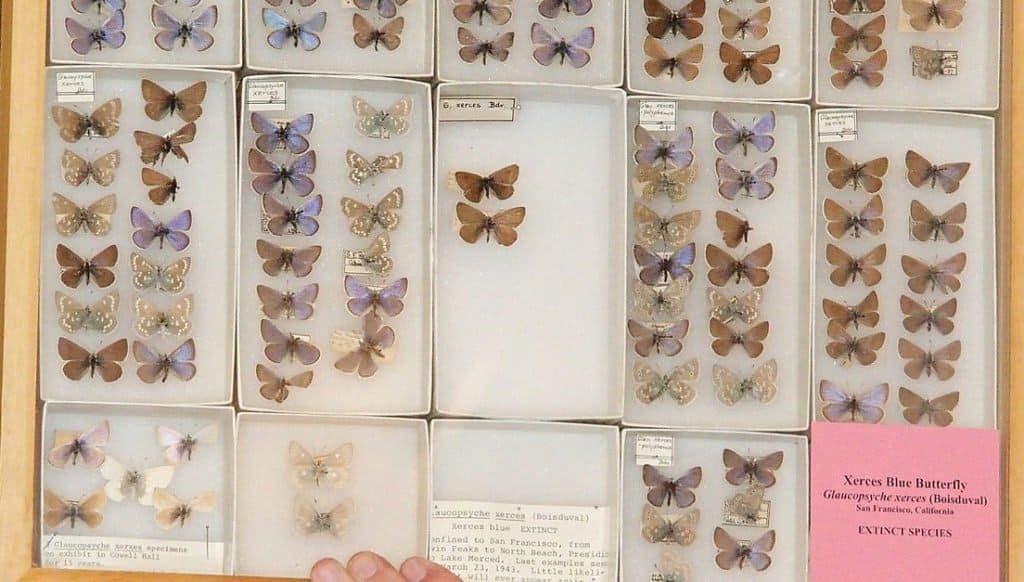
©Edward Rooks from San Jose, CA, USA, CC BY-SA 2.0, via Wikimedia Commons – Original / License
This lovely, powder blue butterfly was found in San Francisco and went extinct in the early 1940s. The butterfly needed lupines and lotus flowers, and this led to its extinction. Because the caterpillars were dependent on lotus plants, the loss of them that came with the development of the city spelled the end of the Xerces blue. Though the adult butterfly could take nectar from lupine flowers, the caterpillar did not eat the plant. There are efforts now to revive the species, and there is a subspecies of the butterfly.
Asides from animals, a lot of plant species are also extinct. Read about some extinct plants in this article.
Summary of 12 Extinct Animal Species
| Rank | Extinct Species |
|---|---|
| 1 | Xerces Blue |
| 2 | Crescent Nail Tail Wallaby |
| 3 | Schomburgk’s Deer |
| 4 | Guam Flying Fox |
| 5 | Javan Tiger |
| 6 | Pyrenean Ibex |
| 7 | Saudi Gazelle |
| 8 | Christmas Island Pipistrelle |
| 9 | Yangtze River Dolphin |
| 10 | Formosan Clouded Leopard |
| 11 | Pinta Giant Tortoise |
| 12 | West African Black Rhinoceros |
| 13 | Ivory-Billed Woodpecker |
The photo featured at the top of this post is © PicturesWild/Shutterstock.com
FAQs (Frequently Asked Questions)
What animals have recently been declared extinct?
Some examples of recently extinct animals include the ivory-billed woodpecker (declared extinct in 2021), splendid poison frog (2020), and Bramble Cay melomys (2019).
Thank you for reading! Have some feedback for us? Contact the AZ Animals editorial team.







